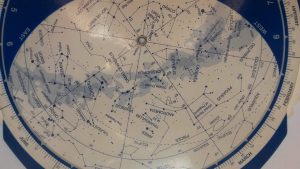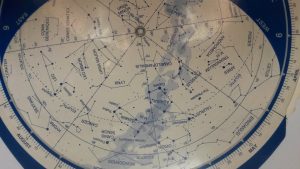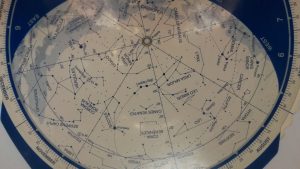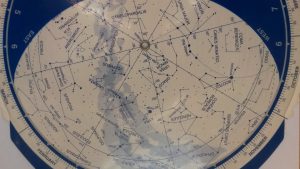“Is it possible to find all 88 constellations in the sky in one night?”
WonderDome visitor, age 11
Sadly, no observer on Earth can see all 88 constellations at once. Which star patterns one can spot at any given night depends on the time, season, the stargazer’s latitude and, obviously, the observational conditions.
Wherever you are on Earth, many stars and constellations always remain hidden from your view by the planet itself. Moreover, because of the Earth’s being in constant motion, your local sky changes both overnight and season to season. But it’s not the shape of the constellations that changes, no, the distances between the stars in one pattern and their mutual positions always* remain the same, but their orientation and location in the sky!
*To be precise, the stars in one constellations are neither gravitationally bound nor are they close together in space. Each one of them follows its own path through our Galaxy. As a result, the shape of the whole pattern changes over a very long time. Stick around for a few hundred years and you will notice it too!
Northern Hemisphere vs Southern Hemisphere
Out of the 88 constellations recognized by the astronomical community, more than half can be seen from the Northern Hemisphere. Some of these patterns (The two bears, Ursa Major and Ursa Minor, Cassiopeia and Cepheus) are circumpolar and therefore can be spotted all year round. But others are only visible in a particular season. The exact number of your circumpolar constellation depends on your latitude! The Southern circumpolar constellations include Crux and Carina.
Despite what many people think, Northern circumpolar constellations can be seen low in the sky from the tropical regions (up to 25 degrees South) in the Southern Hemisphere. And similarly, the Southern circumpolar constellations can be seen up to 25 degrees North of the Equator!
Constellations through the year
Every night we see the stars overlooking the night side of the Earth, i.e. those that are on the opposite side from the Sun! That means every season our “field of view” turns by 90 degrees. During the winter and in the Summer, for example, we are looking at the opposite sides of the celestial sphere! As the Earth orbits around the Sun, the constellations appear to move West, rising two hours earlier every next month.
From our Northern Mid-latitudes the following seasonal star patterns are easy to find on the night sky:

Spring: Leo, Bootes, Virgo, Cancer

Summer: Hercules, Lyra, Draco, Cygnus

Autumn: Pegasus, Andromeda, Perseus, Cassiopeia, Aquarius

Winter: Orion, Gemini, Canis Major and Canis Minor, Taurus, Auriga
As you have probably already guessed, stargazers in the Southern Hemisphere can observe the Northern Winter constellations in the Summer, the Northern Autumn constellations in the Spring and so on. And yes, they see them upside down!
Constellations night-to-night
If you ever watched the sky for several hours over one night, you know that the star patterns move across the sky. This is due to the Earth’s axial rotation!
All the seasonal constellation, as well as planets and the Moon, rise and set.
Circumpolar constellations, on the other hand, always stay above the horizon. They circle around their poles, turning sideways and upside down as they go. In the Northern Hemisphere they turn around the North Star (learn more about the North Star in our space blog The mystery of the North Star). In the Southern Hemisphere – around an unmarked point on the sky as there are no bright stars near the South Celestial Pole.
Looking for constellation
Any clear sky night is great for stargazing. Just grab your sky map and enjoy a game of celestial dot-to-dot. Alternatively, visit a stargazing session in our inflatable dome and learn all about seasonal constellations and famous stars. And the best part? You can do it in the daytime! Check our https://wonderdome.co.uk/ website and WonderDome Facebook page to find out how to book our stardome or when the next public stargazing session is.

